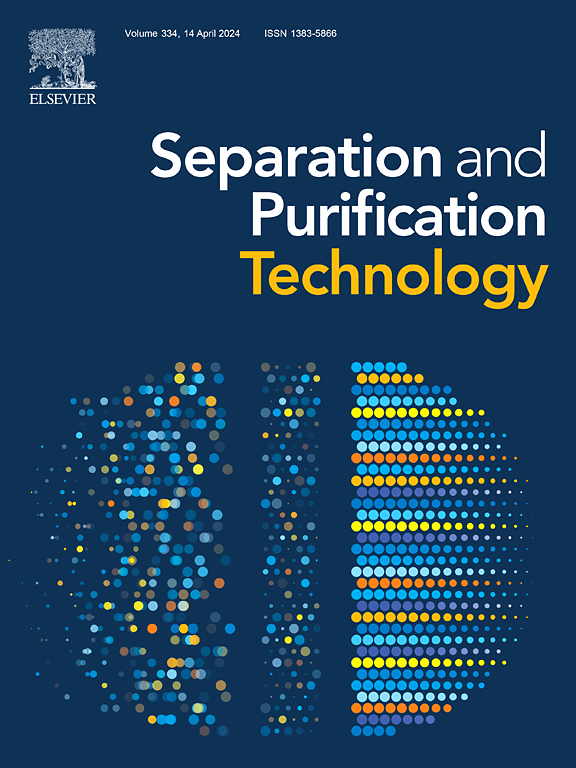羧甲基-β-环糊精-二氧化硅多孔磁性复合材料对废水中低浓度稀土元素的分离和回收
IF 8.1
1区 工程技术
Q1 ENGINEERING, CHEMICAL
引用次数: 0
摘要
传统的吸附剂用于去除废水中的稀土,由于缺乏选择性和回收困难,在实践中往往受到限制。为了解决这一问题,通过缩合反应成功合成了表面含有分散良好的羧甲基-β-环糊精(CM-β-CD)的磁性核壳复合材料Fe3O4@SiO2,并将其作为高效吸附剂(Fe3O4@SiO2@CM-β-CD)用于去除Er(Ⅲ)。采用FI-IR、SEM/TEM、XRD、VSM、BET、TGA、XPS等先进手段对所制备的磁性杂化材料进行了表征和分析。结果表明:Fe3O4@SiO2@CM-β-CD具有球状结构、结晶性能、耐热多孔性;考察了金属离子初始浓度、溶液pH、共存杂质离子及其他稀土元素对Er(Ⅲ)吸附性能的影响。结果表明,该材料在pH为4.5时吸附性能最佳。最大吸附量为13.63 mg·g−1。吸附过程可以用Langmuir等温线和拟二级动力学方程描述,表明吸附为单层化学吸附。通过热力学数据分析,Fe3O4@SiO2@CM-β-CD吸附Er(Ⅲ)的过程为自发吸热反应。进一步在溶液中引入Na(Ⅰ)、Mg(Ⅱ)、Ca(Ⅱ)、Zn(Ⅱ)、Ni(Ⅱ)和Al(Ⅲ)离子,研究Fe3O4@SiO2@CM-β-CD的吸附选择性。除三价Al(Ⅲ)对吸附性能有强烈干扰外,Fe3O4@SiO2@CM-β-CD对其他金属离子均表现出良好的吸附选择性。另外,Fe3O4@SiO2@CM-β-CD在使用HCl溶液6次循环后仍保持较高的吸附性能。相互作用机理的研究表明,在Er(Ⅲ)的吸附过程中,含氧官能团和含氮官能团作为给电子基团参与了与Er(Ⅲ)的配位反应,从而实现了高效吸附。本文章由计算机程序翻译,如有差异,请以英文原文为准。

Separation and recovery of low-concentration rare earth elements from wastewater using a porous magnetic composite of carboxymethyl-β-cyclodextrin and silica
The traditional adsorbents using to remove rare earths from wastewater is often restricted in practice due to the lack of selectivity and difficult recovery. To resolve this problem, the magnetic core–shell composites Fe3O4@SiO2 containing well-dispersed carboxymethyl-β-cyclodextrin (CM-β-CD) on the surface have been successfully synthesized through the condensation reaction and used as high-efficiency adsorbents (Fe3O4@SiO2@CM-β-CD) for removal of Er(Ⅲ). The obtained magnetic hybrid materials were characterized and analyzed by the advanced means (FI-IR, SEM/TEM, XRD, VSM, BET, TGA, XPS). The results showed that Fe3O4@SiO2@CM-β-CD has spheric structure, crystalline properties and are heat-resistant and porous. The effects of initial concentration of metal ions, solution pH, coexisting impurity ions and other rare earths on adsorption of Er(Ⅲ) performance were investigated. According to the results, the materials achieved the best adsorption performance at pH 4.5. The maximum adsorption capacity was 13.63 mg·g−1. The adsorption process can be described by the Langmuir adsorption isotherm and pseudo-second-order kinetic equation, and indicating that the adsorption was monolayer chemical adsorption. Through thermodynamic data analysis, the adsorption process of Er(Ⅲ) by Fe3O4@SiO2@CM-β-CD was a spontaneous endothermic reaction. Na(Ⅰ), Mg(Ⅱ), Ca(Ⅱ), Zn(Ⅱ), Ni(Ⅱ) and Al(Ⅲ) ions were further introduced in the solution to study the adsorption selectivity of Fe3O4@SiO2@CM-β-CD. Except for trivalent Al(Ⅲ), which strongly interferes with adsorption performance, Fe3O4@SiO2@CM-β-CD exhibited good adsorption selectivity for other metal ions. Additionally, it was confirmed that Fe3O4@SiO2@CM-β-CD still maintained high adsorption performance after 6 cycles of using HCl solution. The investigation of interaction mechanism showed that during the adsorption process of Er(Ⅲ), oxygen-containing functional groups and nitrogen-containing functional groups as electron-donating groups participated in the coordination reaction with Er(Ⅲ), thus achieving efficient adsorption.
求助全文
通过发布文献求助,成功后即可免费获取论文全文。
去求助
来源期刊

Separation and Purification Technology
工程技术-工程:化工
CiteScore
14.00
自引率
12.80%
发文量
2347
审稿时长
43 days
期刊介绍:
Separation and Purification Technology is a premier journal committed to sharing innovative methods for separation and purification in chemical and environmental engineering, encompassing both homogeneous solutions and heterogeneous mixtures. Our scope includes the separation and/or purification of liquids, vapors, and gases, as well as carbon capture and separation techniques. However, it's important to note that methods solely intended for analytical purposes are not within the scope of the journal. Additionally, disciplines such as soil science, polymer science, and metallurgy fall outside the purview of Separation and Purification Technology. Join us in advancing the field of separation and purification methods for sustainable solutions in chemical and environmental engineering.
 求助内容:
求助内容: 应助结果提醒方式:
应助结果提醒方式:


